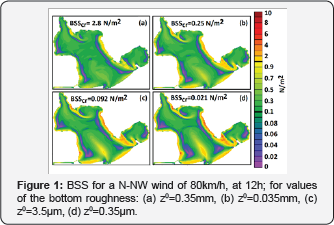Submerged Aquatic Vegetation Restoration in Brackish Ecosystems Subject to Strong Winds and Coastal Jets
Alekseenko E1,2* and Roux B3
1PP Shirshov Institute of Oceanology, Russia
2People's Friendship University of Russia, Russia
3Aix-Marseille University, France
Submission: March 03, 2017; Published: May 11, 2017
*Corresponding author: Alekseenko Elena, PP Shirshov Institute of Oceanology, Russian Academy of Sciences and People's Friendship University of Russia, Moscow, Russia, Email: lena.alekseenko@gmail.com
How to cite this article: Alekseenko E, Roux B. Submerged Aquatic Vegetation Restoration in Brackish Ecosystems Subject to Strong Winds and Coastal Jets. Ocean & fish Open Access J. 2017; 2(4): 555595. DOI: 10.19080/OFOAJ.2017.02.555595
Abstract
The bottom shear stress (BSS) in a windy Mediterranean lagoon has been carefully investigated through numerical modelling. BSS maps have been obtained for the entire lagoon. The aim is to compare BSS with its critical value in the near shoreareas selected for SAV replanting which are subject to downwind coastal jets.
Keywords: Submerged aquatic vegetation Restoration; Lagoon; Bottom shear stress
Abbreviations: SAV: Submerged Aquatic Vegetation; EB: Etang de Berre, BSS: Bottom Shear Stress; N-NW Wind: North-North Western wind
Introduction
This paper concerns a numerical simulation of the hydrodynamics in a windy brackish ecosystem-Etang de Berre (EB) lagoon, which was occupied, at the turn of the 20th century, by extensive Zostera noltii meadows (over 6000ha), which shrinked to about 1.5ha in 2004 due to environmental impacts of hydroelectric power and other anthropogenic developments as it is reported by Warner [1]. Over the last few decades, there have been global declines in seagrass abundance in many places in the world, in particular along the Mediterranean coast and in the coastal lagoons [2]. And so, management decisions aimed at protecting and restoring submerged aquatic vegetation (SAV) have been taken in many places [3-10]. Such a restoration of coastal SAV is known to be very important, among other functions, to restore a fish habitat.
EB is one of the largest Mediterranean brackish lagoons (surface 155km2; volume 0.98* 109m3; mean depth 6.5m and maximum depth 9.5m). Three main freshwater sources are situated in the Northern part of the lagoon: a hydroelectricity power channel with a maximum runoff capability of 250m3/s during the winter season, and two rivers (Arc and Touloubre), with mean runoff equal to 15m3/s and 10m3/s, respectively. EB is connected to the Mediterranean Sea through a long and narrow channel, called Caronte. It permits the passage of seawater into EB.
A peculiarity of this lagoon is that it is often subjected to strong winds. As it is shown by the weather database provided by SOGREAH [11] a daily average wind speed exceeds 36km/h for over 102 days per year [12]. The dominant winds direction is N-NW. Our previous numerical investigations [12-14] showed that such winds create a very complex circulation in the lagoon, including downwind coastal jets and a bottom shear stress which can impact the mud/sand sediment composition and erosion, damaging the SAV root system. Indeed, the bottom velocity is expected to be responsible for sediment transport (erosion, followed by sedimentation) and changes of sediment composition (mud/sand) in the near shore areas where Zostera noltei have to be replanted.
This study is devoted to a better knowledge of the flow regimes driven by three meteorological, oceanic and anthropogenic forcings in this lagoon:
- Baroclinic pressure gradient at the entrance of Caronte channel, with mini-tide.
- Huge freshwater runoff from hydro power plant and rivers, strong wind.
- The goal is to provide a guide to select the most pertinent near shore places for a replanting program.
For that, a special attention is devoted to the prediction of the bottom shear stress (BSS) in the whole lagoon and to compare it with the critical value for erosion.
Methods
The study is realized by using the MARS3D hydrodynamic model provided by [15,16]. It is a hydro dynamical model based on the equations proposed by Blumberg [17] the system of incompressible Reynolds Averaged Navier-Stokes equations in the classical Boussinesq approximation with the hydrostatic assumption. It also takes into account the Coriolis force in the momentum equations.
The numerical aspects of EB configuration and its hydrodynamic simulation were described in [13,14] where the effects of refinement of the sigma-grid on the computed velocity fields were examined in order to choose an optimal grid for appropriate accuracy and acceptable computational time. The numerical model has been carefully validated in [12] by comparison with daily observations of the vertical salinity and temperature profiles at three mooring stations, for a long period of one year. A quite good agreement has been observed with the measurements.
Results

The calculations of the bottom shear stress (BSS) have been performed for several values of the bottom roughness parameter z0, to cover various kinds of sediments existing in different EB near shore areas (from silts and sands, to fine gravels). The BSS maps obtained for the entire EB lagoon are given in Figure 1, for the N-NW wind speed of 80km/h. It is particularly interesting to analyze the results in the near shore replanting areas on the eastern and the western sides. They are all subject to the downwind coastal jet created by the N-NW wind. We observe that BSS is larger near the shoreline and decreases along any transect perpendicular to the shoreline. There exists a zone, parallel to the shore line, where BSS presents a minimum (equal to zero). It corresponds to the specific characteristic of the downwind coastal jet: all along the shorelines, the currents at the surface and at the bottom are downwind, while at a certain distance from the shoreline, the bottom current is opposite (since the lagoon is semi-enclosed).
To better understand, at least qualitatively, the impact of such BSS on the sediment mobility in the replanting areas, we have to estimate the critical BSS value, BSS , at which such a mobility would occur. An evaluation of BSScr, is proposed by Berenbrock [18] for a large range of particle diameters d. Furthermore, according to Dufois and Le Hir [19], the bottom roughness parameter z0 can be connected to the grain-size, roughness, d, by the following relation: z0=2.5d/30 (see their Appendix 1). Then, the critical values of BSS for sediment mobility, obtained by interpolation for our z0, are given on the Figure 1
Discussion and Conclusion
This work is focused on the hydrodynamics and bottom shear stress throughout a windy coastal lagoon, in particular, in the near shore areas selected for a replanting program of submerged aquatic vegetation (Zostera noltei). The goal was to evaluate the areas for which BSS would overpass BSScr.
When the bottom roughness increases (from silts to gravels), BSS slowly decreases for each of the four control points. And the comparison with BSScr, show that for the smaller roughness values, the BSS largely exceeds this critical value. This confirms the possibility that the coastal jet could generate sediment mobility leading to a negative impact for SAV replanting.
Our BSS results can be used as a guide for the selection of future near shore replanting sites. Most of the places initially selected in EB for the replanting program appeared to be not productive. The present study could be useful to select more relevant near shore areas for a possible extension of the replanting program, after an appropriate characterization of bottom sediments. More generally, the present study will be useful to alert the persons in charge of replanting programs in other sites in the world (lagoons, estuaries, lakes) subject to strong winds and coastal jets, to take into account the large variation of BSS in the nearshore areas subject to coastal jets.
Acknowledgement
We acknowledge financial supports by the French Water Agency (Agence de l'Eau-RMC- convention N 2010-0042) and by the Regional Council (Conseil Regional Provence-Alpes-Cote d'Azur): Projet HYDROSYS - Subvention N 2008-11944CA and the French Ministry of Foreign Affairs (ARCUS-Russia program). We also acknowledge PhD grants received from the French Ministry of Higher Education and Research (Direction des Relations Europeennes et Internationales et de la Cooperation: reseau formation recherche Franco-Russe). Part of this research is also a contribution to the grant of Russian Foundation for Basic Research (RFBR) N16-35-00526.
References
- Warner RF (2012) Environmental impacts of hydroelectric power and other anthropogenic developments on the hydro morphology and ecology of the durance channel and the Etang de Berre, southeast France. J Environ Manage 104: 35-50.
- HCMR, EEA (2009) Distribution of the Marine Angiosperm Posidonia Oceanica and Zostera sp. in the Mediterranean.
- Cardoso PG, Raffaelli D, Pardal MA (2008) The impact of extreme weather events on the seagrass Zostera noltii and related Hydrobiaulvae population. Mar Pollut Bull 56(3): 483-492.
- Fonseca MS, Kenworthy WJ, Courtney FX (1996) Development of planted seagrass beds in Tampa Bay, Florida, USA. I. Plant components. Marine Ecology Progress Series 132: 127-139.
- Koch EW, Sanford LP, Chen SN, Deborah JS, McKee J (2006) Waves in Seagrass Systems: Review and Technical Recommendations. USA Corps of Eng report ERDC TR-06-15.
- Koch EW, Barbier EB, Silliman BR, Reed DJ, Perillo GME, et al. (2009) Non-linearity in ecosystem services: temporal and spatial variability in coastal protection. Front Ecol Environ 7(1): 29-37.
- Pickerell CH, Schott S, Wyllie-ES (2006) Buoy-deployed seeding: A new low cost technique for restoration of submerged aquatic vegetation from seed. SAV Technical Notes Collection (ERDC/TN SAV-06-2). US Army Engineer Research and Development Center, Vicksburg, Mississippi, USA.
- Shafer D, Bergstrom P (2010) An Introduction to a Special Issue on Large-Scale Submerged Aquatic Vegetation Restoration Research in the Chesapeake Bay: 2003-2008. Restoration Ecology 18(4): 481-488.
- Vachi M, Montefalcone M, Bianchi CN, Morri C, Ferrari M (2012) Hydrodynamic constraints to the seaward development of Posidonia oceanica meadows. Estuarine, Coastal and Shelf Science 97: 58-65.
- Van der Heide T, van Nes EH, Geerling GW, Smolders AJP, Bouma TJ, et al. (2007) Positive feedbacks in seagrass ecosystems: Implications for success in conservation and restoration. Ecosystems 10(8): 13111322.
- SOGREAH (2003) Berre e Etudes de premiere phase, Evaluation comparative des impacts maritimes des solutions B et T. rapport MAR/ PSI- 2360023.
- Alekseenko E, Roux B, Fougere D, Chen PG (2017) The effect of wind induced bottom shear stress and salinity on Zostera noltii replanting in a Mediterranean coastal lagoon. Estuarine, Coastal and Shelf Science 187: 293-305.
- Alekseenko E, Roux B, Sukhinov A, Kotarba R, Fougere D (2013) Coastal hydrodynamics in a windy lagoon. Comput Fluids 77: 24-35.
- Alekseenko E, Roux B, Sukhinov A, Kotarba R, Fougere D (2013) Near shoreline hydrodynamics in a Mediterranean lagoon. Nonlinear Process Geophys 20: 189-198.
- Lazure P, Dumas F (2008) An external-internal mode coupling for a 3D hydrodynamical model for applications at regional scale (MARS). Adv Wat Res 31(2): 233-250.
- Lazure P, Garnier V, Dumas F, Herry Ch, Chifflet M (2009) Development of a hydrodynamic model of the Bay of Biscay. Validation of hydrology. Cont Shelf Res 29(8): 985-997.
- Blumberg AF, Mellor GL (1986) A description of a Tree-Dimensional Coastal Ocean Circulation Model, Geophysical Fluid Dynamics Program, Princeton University, Princeton, New Jersey, USA, pp. 1-16.
- Berenbrock C, Tranmer AW (2008) Simulation of Flow, Sediment Transport, and Sediment Mobility of the Lower Coeur d'Alene River, Idaho. Scientific Investigations Report 2008-5093, US Environmental Protection Agency, USA, p. 164.
- Dufois F, Le Hir P (2015) Formulating fine to Medium sand erosion for suspended sediment transport models. J Mar Sci Eng 3(3): 906-934.






























